Seismic Performance Evaluation of Reinforced Concrete Building Structure Retrofitted with Self-Centering Disc-Slit Damper and Conventional Steel Slit Damper
Abstract
:1. Introduction
2. Self-Centering Damper and Analytical Model
2.1. Configuration of SC-DSD
2.2. Cyclic Loading Test and Analytical Model
3. Seismic Retrofitting of Structure with SC-DSDs
3.1. Structural Modeling of Archetype Building Structure
3.2. Nonlinear Static Analysis
3.3. Design of Self-Centering Disc Slit Damper
4. Comparative Seismic Performance Analysis of Original and Retrofitted Structures
4.1. Ground Motion Records
4.2. Analysis and Results from Nonlinear Time History Simulation
5. Conclusions
- The seismic performance of a six-story RC structure was analyzed, retrofitted using a SC-DSD and a conventional Steel Slit Damper (SD), and compared with the bare structure.
- Comparative analysis using nonlinear dynamic analyses showed seismically retrofitted structures using the capacity spectrum method effectively mitigated inter-story drift ratio below the 1% target performance level of the life-safety limit state.
- Analysis of displacement time histories highlighted the SC-DSD’s ability to reduce maximum displacement by up to 31% and eliminate permanent residual deformations compared to conventional SD retrofitted structures.
- Time history analysis of hysteretic energy demonstrated that SC-DSDs effectively dissipated 80% of seismic-induced energy. At the same time, structural elements remained within the elastic range, meeting code requirements under design-level earthquake loads.
- The design of the SC-DSD using performance point and equivalent damping ratio obtained through the capacity spectrum method proved to be an accurate approach for designing structures that incorporate this technology.
- The SC-DSD system, with its lightweight design, compact size, and reusability, emerges as a cost-effective solution for enhancing the seismic performance of building structures through retrofitting.
Author Contributions
Funding
Data Availability Statement
Acknowledgments
Conflicts of Interest
References
- Whittaker, A. Earthquake simulator testing of steel plate added damping. In Earthquake Engineering; University of California: Berkeley, CA, USA, 1989. [Google Scholar]
- Tsai, C.S.; Chen, K.C.; Chen, C.S. Seismic resistibility of high-rise buildings with combined velocity-dependent and velocity-independent devices. ASME-PUBLICATIONS-PVP 1998, 366, 103–110. [Google Scholar]
- Mualla, I.H.; Belev, B. Performance of steel frames with a new friction damper device under earthquake excitation. Eng. Struct. 2002, 24, 365–371. [Google Scholar] [CrossRef]
- Benavent-Climent, A. Seismic Design of Structures by Using Brace-Type Hysteretic Dampers; University of Tokyo (Japan): Tokyo, Japan, 1998. [Google Scholar]
- Benavent-Climent, A.; Morillas, L.; Vico, J.M. A study on using wide-flange section web under out-of-plane flexure for passive energy dissipation. Earthq. Eng. Struct. Dyn. 2011, 40, 473–490. [Google Scholar] [CrossRef]
- Sheikh, H.; Van Engelen, N.C.; Ruparathna, R. A review of base isolation systems with adaptive characteristics. In Structures; Elsevier: Amsterdam, The Netherlands, 2022; Volume 38, pp. 1542–1555. [Google Scholar]
- Kim, J.; Choi, H. Behavior and design of structures with buckling-restrained braces. Eng. Struct. 2004, 26, 693–706. [Google Scholar] [CrossRef]
- Yang, C.-S.W.; DesRoches, R.; Leon, R.T. Design and analysis of braced frames with shape memory alloy and energy-absorbing hybrid devices. Eng. Struct. 2010, 32, 498–507. [Google Scholar] [CrossRef]
- Darani, F.M.; Sahami, K.; Zarnani, P.; Veismoradi, S.; Bagheri, H.; Quenneville, P.; Haemmerle, E. Rocking Concrete Shear Walls with Self-Centring Friction Dampers for Seismic Protection of Building Structures. Available online: https://data.smar-conferences.org/SMAR_2019_Proceedings/Inhalt/we.3.b.4.pdf (accessed on 17 February 2024).
- Naeem, A.; Kim, J. Seismic retrofit of a framed structure using damped cable systems. Steel Compos. Struct. 2018, 29, 287–299. [Google Scholar]
- Naeem, A.; Eldin, M.N.; Kim, J.; Kim, J. Seismic performance evaluation of a structure retrofitted using steel slit dampers with shape memory alloy bars. Int. J. Steel Struct. 2017, 17, 1627–1638. [Google Scholar] [CrossRef]
- Naeem, A.; Kim, J. Seismic performance evaluation of a spring viscous damper cable system. Eng. Struct. 2018, 176, 455–467. [Google Scholar] [CrossRef]
- Naeem, A.; Kim, J. Seismic retrofit of 3000 kVA power transformer using friction dampers and prestressed tendons. Structures 2021, 32, 641–650. [Google Scholar] [CrossRef]
- Golzar, F.G.; Rodgers, G.W.; Chase, J.G. Design and experimental validation of a re-centring viscous dissipater. Structures 2018, 13, 193–200. [Google Scholar] [CrossRef]
- Rodgers, G.W.; Mander, J.B.; Chase, J.G.; Dhakal, R.P. Beyond ductility: Parametric testing of a jointed rocking beam-column connection designed for damage avoidance. J. Struct. Eng. 2016, 142, C4015006. [Google Scholar] [CrossRef]
- Chi, P.; Guo, T.; Peng, Y.; Cao, D.; Dong, J. Development of a self-centering tension-only brace for seismic protection of frame structures. Steel Compos. Struct. 2018, 26, 573–582. [Google Scholar]
- Shu, Z.; Li, Z.; He, M.; Zheng, X.; Wu, T. Seismic design and performance evaluation of self-centering timber moment resisting frames. Soil Dyn. Earthq. Eng. 2019, 119, 346–357. [Google Scholar] [CrossRef]
- Guan, X.; Burton, H.; Moradi, S. Seismic performance of a self-centering steel moment frame building: From component-level modeling to economic loss assessment. J. Constr. Steel Res. 2018, 150, 129–140. [Google Scholar] [CrossRef]
- Chan, R.W.; Albermani, F. Experimental study of steel slit damper for passive energy dissipation. Eng. Struct. 2008, 30, 1058–1066. [Google Scholar] [CrossRef]
- Naeem, A.; Kim, J. Seismic performance evaluation of a multi-slit damper. Eng. Struct. 2019, 189, 332–346. [Google Scholar] [CrossRef]
- Javidan, M.M.; Nasab, M.S.; Kim, J. Full-scale tests of two-story RC frames retrofitted with steel plate multi-slit dampers. Steel Compos. Struct. 2021, 39, 645–664. [Google Scholar]
- Lee, J.; Kim, J. Seismic performance evaluation of moment frames with slit-friction hybrid dampers. Earthq. Struct. 2015, 9, 1291–1311. [Google Scholar] [CrossRef]
- Lee, J.; Kim, J. Development of box-shaped steel slit dampers for seismic retrofit of building structures. Eng. Struct. 2017, 150, 934–946. [Google Scholar] [CrossRef]
- Wang, W.; Fang, C.; Shen, D.; Zhang, R.; Ding, J.; Wu, H. Performance assessment of disc spring-based self-centering braces for seismic hazard mitigation. Eng. Struct. 2021, 242, 112527. [Google Scholar] [CrossRef]
- Fang, C.; Wang, W.; Shen, D. Development and experimental study of disc spring–based self-centering devices for seismic resilience. J. Struct. Eng. 2021, 147, 04021094. [Google Scholar] [CrossRef]
- Zarnani, P.; Quenneville, P. A Resilient Slip Friction Joint; NZ IP Office: Wellington, New Zealand, 2015.
- Darani, F.M.; Zarnani, P.; Veismoradi, S.; Yousef-Beik, S.M.M.; Hashemi, A.; Quenneville, P. Resilient slip friction joint performance: Component analysis, spring model and anti-locking mechanism. Structures 2021, 33, 3897–3911. [Google Scholar] [CrossRef]
- Xu, L.; Fan, X.; Li, Z. Cyclic behavior and failure mechanism of self-centering energy dissipation braces with pre-pressed combination disc springs. Earthq. Eng. Struct. Dyn. 2017, 46, 1065–1080. [Google Scholar] [CrossRef]
- Jafari, A.; Sadeghi, M.; Alaee, F.J.; Bengar, H.A. Determining the optimal layout of energy-dissipating mechanisms for hybrid self-centering walls. Structures 2024, 60, 105854. [Google Scholar] [CrossRef]
- Naeem, A.; Maida, Y.; Koichi, K.; Javidan, M.M. Development and experimental verification of self-centering disc slit damper for buildings. J. Constr. Steel Res. 2023, 201, 107759. [Google Scholar] [CrossRef]
- Xu, L.; Fan, X.; Li, Z. Hysteretic analysis model for pre-pressed spring self-centering energy dissipation braces. J. Struct. Eng. 2018, 144, 04018073. [Google Scholar] [CrossRef]
- Ismail, M.; Ikhouane, F.; Rodellar, J. The hysteresis Bouc-Wen model, a survey. Arch. Comput. Methods Eng. 2009, 16, 161–188. [Google Scholar] [CrossRef]
- Soleimani, R.; Hamidi, H.; Khosravi, H. On advantages of the “Substitute Frame” model for incremental dynamic analysis: Integration of speed and accuracy. Structures 2022, 39, 266–277. [Google Scholar] [CrossRef]
- Usefi, N.; Sharafi, P.; Ronagh, H. Numerical models for lateral behaviour analysis of cold-formed steel framed walls: State of the art, evaluation and challenges. Thin Walled Struct. 2019, 138, 252–285. [Google Scholar] [CrossRef]
- FEMA. Prestandard, Interim Testing Protocols for Determining the Seismic Performance Characteristics of Structural and Nonstructural Components; (FEMA 461); Federal Energency Management Agency: Washington, DC, USA, 2007.
- American Society of Civil Engineers. Minimum Design Loads and Associated Criteria for Buildings and Other Structures, ASCE/SEI 7-22; American Society of Civil Engineers: Reston, VA, USA, 2022. [Google Scholar]
- ASCE/SEI Seismic Rehabilitation Standards Committee. Seismic Rehabilitation of Existing Buildings (ASCE/SEI 41-13); American Society of Civil Engineers: Reston, VA, USA, 2014. [Google Scholar]
- PERFORM. 3D User Manual (v8. 0.1). Computer and Structures. 2011. Available online: https://wiki.csiamerica.com/display/perform/Program+usage (accessed on 17 February 2024).
- ATC A. 40. Seismic Evaluation and Retrofit of Concrete Buildings; Applied Technology Council: Redwood City, CA, USA, 1996. [Google Scholar]
- PEER N. Database. Pacific Earthquake Engineering Research Center: NGA Database; University of California: Berkeley, CA, USA, 2007. [Google Scholar]
- Chopra, A.K. Dynamics of Structures; Pearson Education: London, UK, 2007. [Google Scholar]


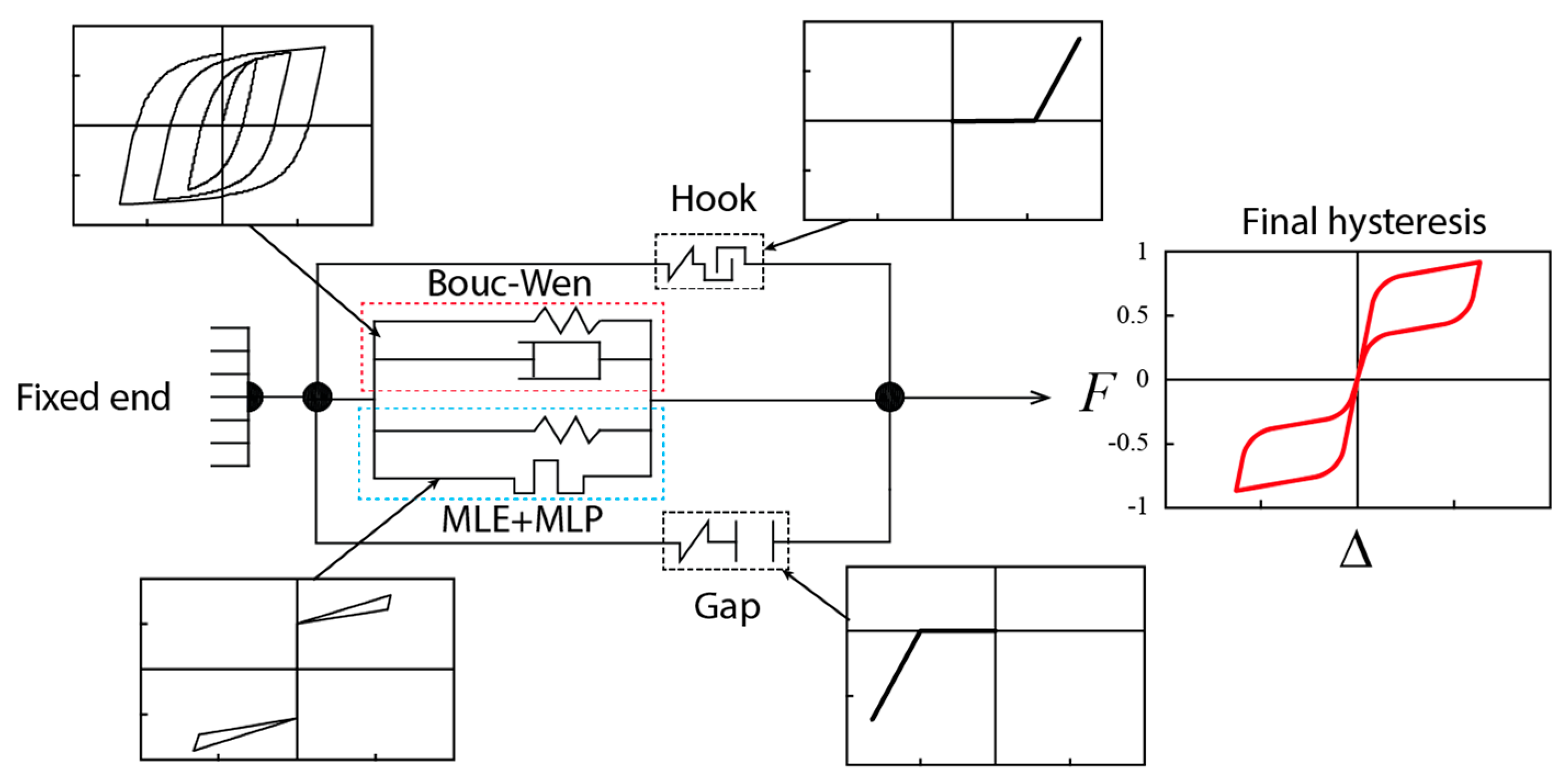



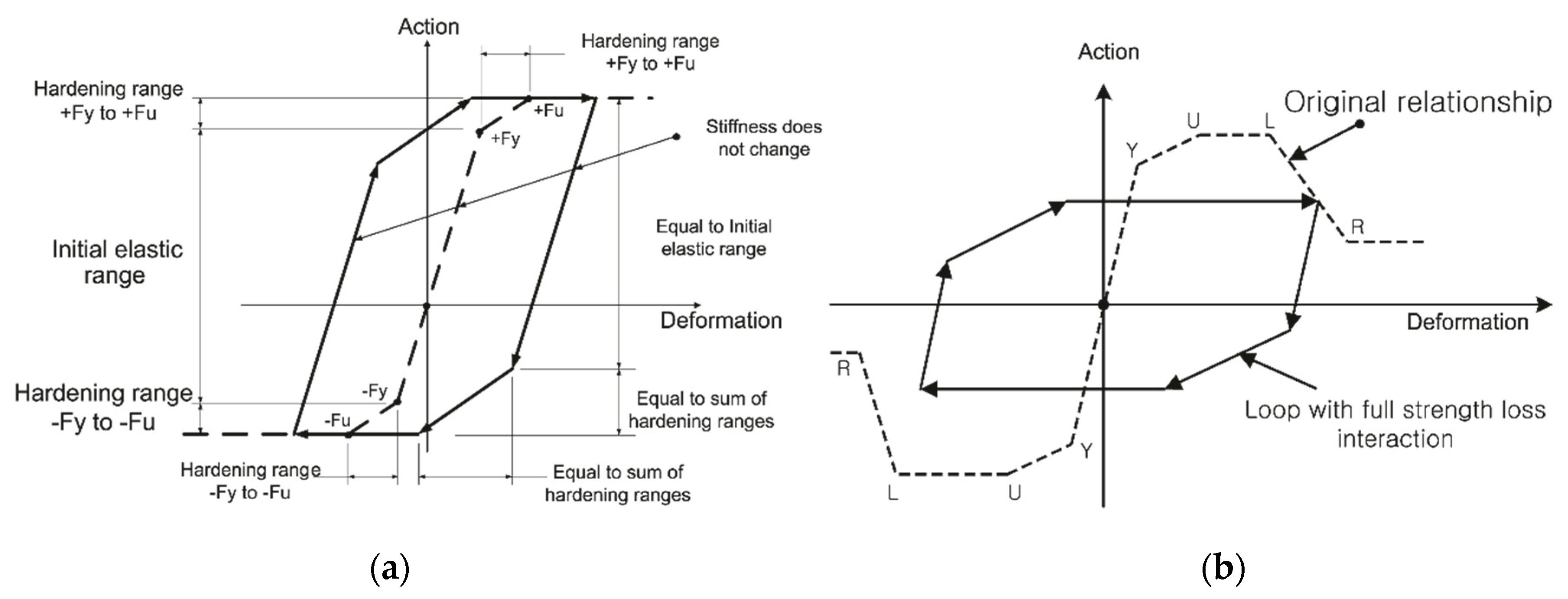

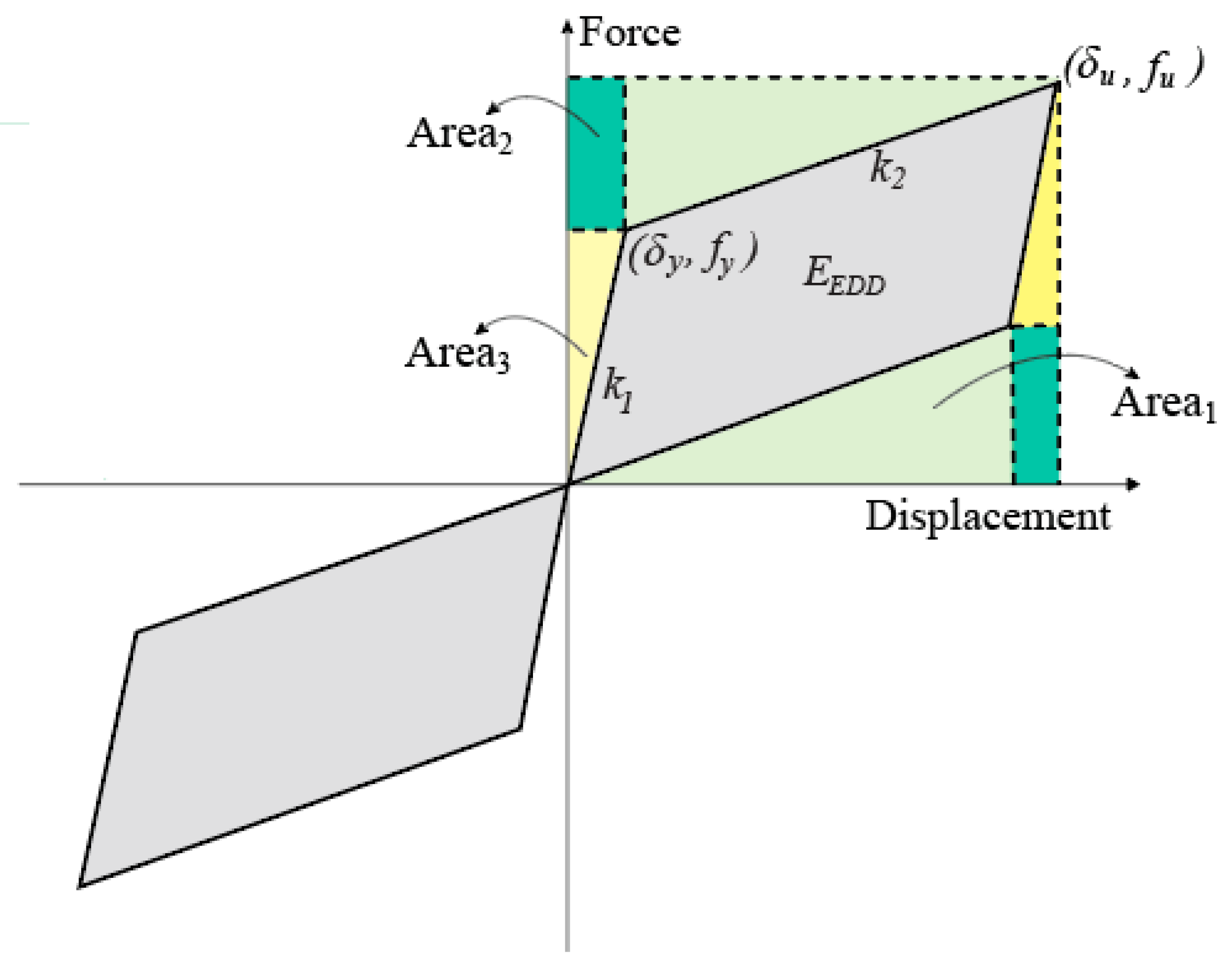

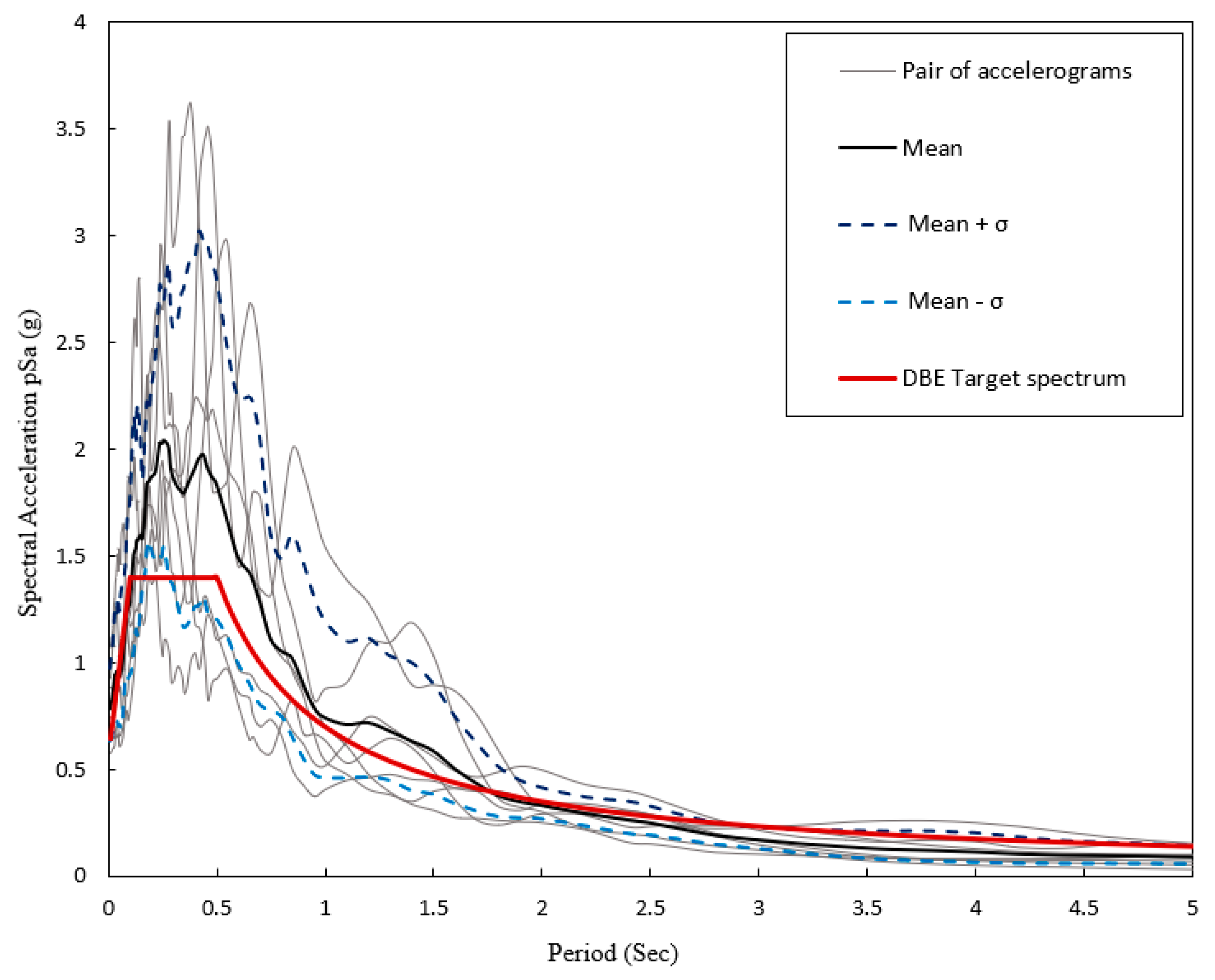
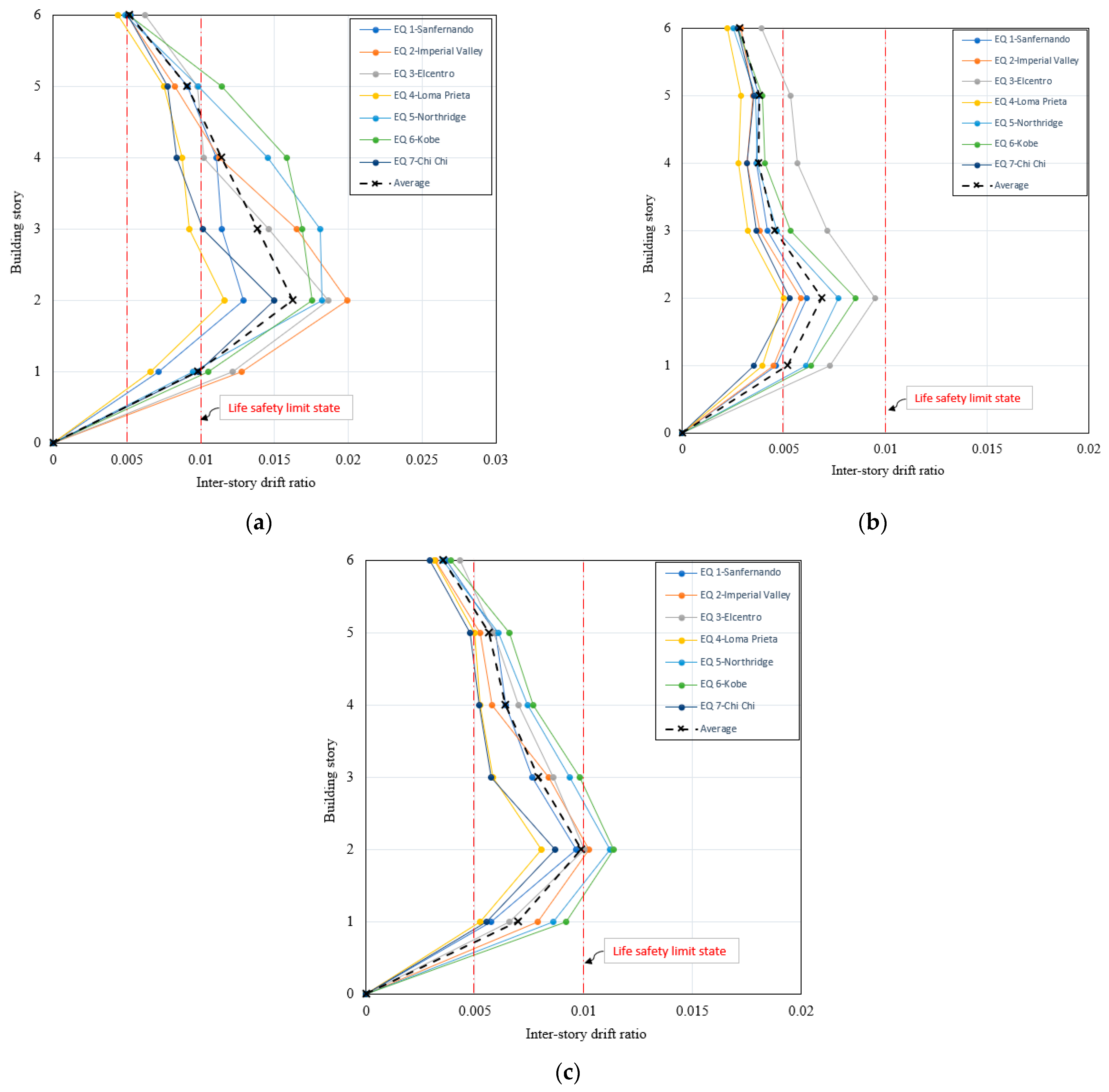

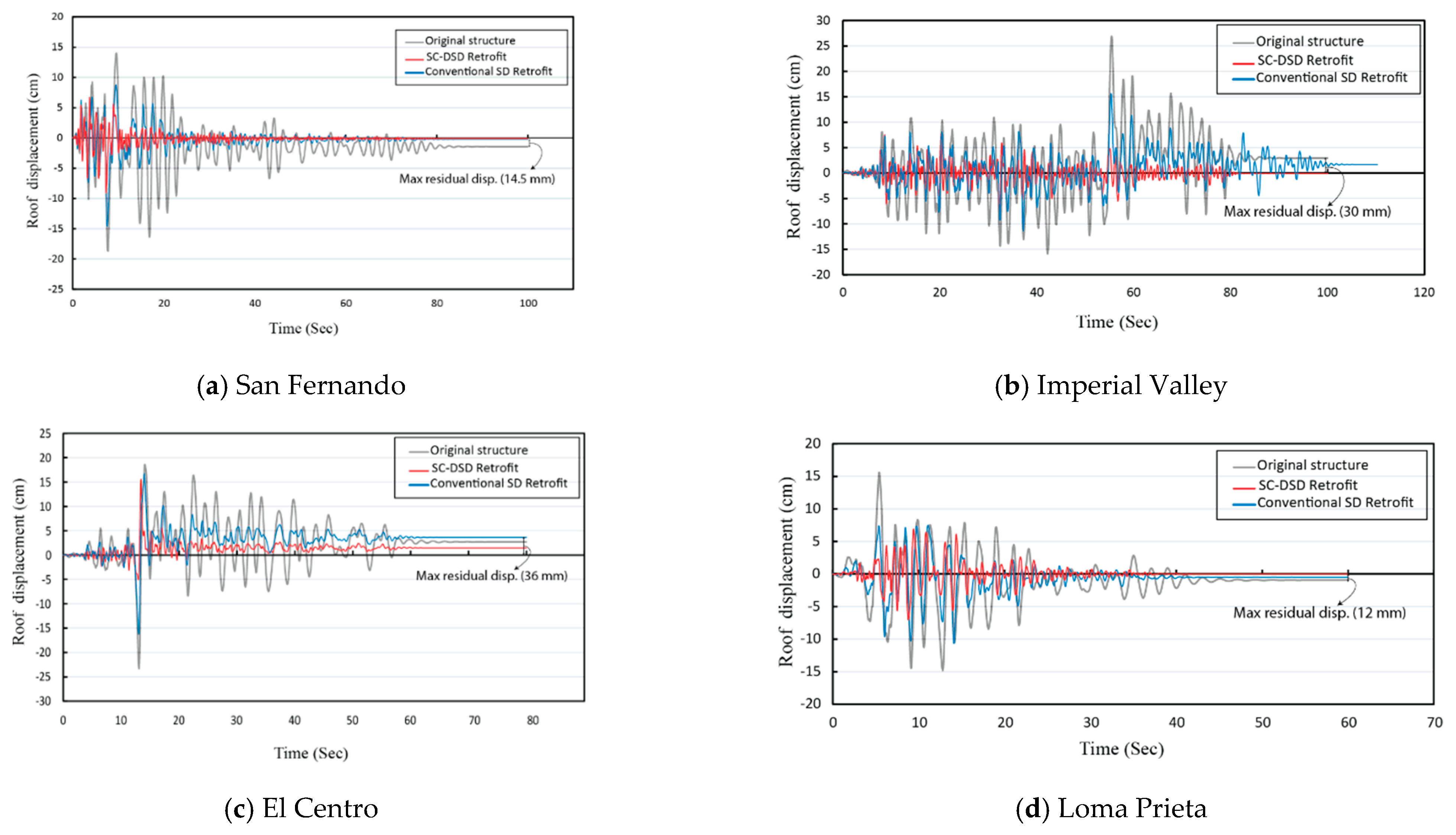

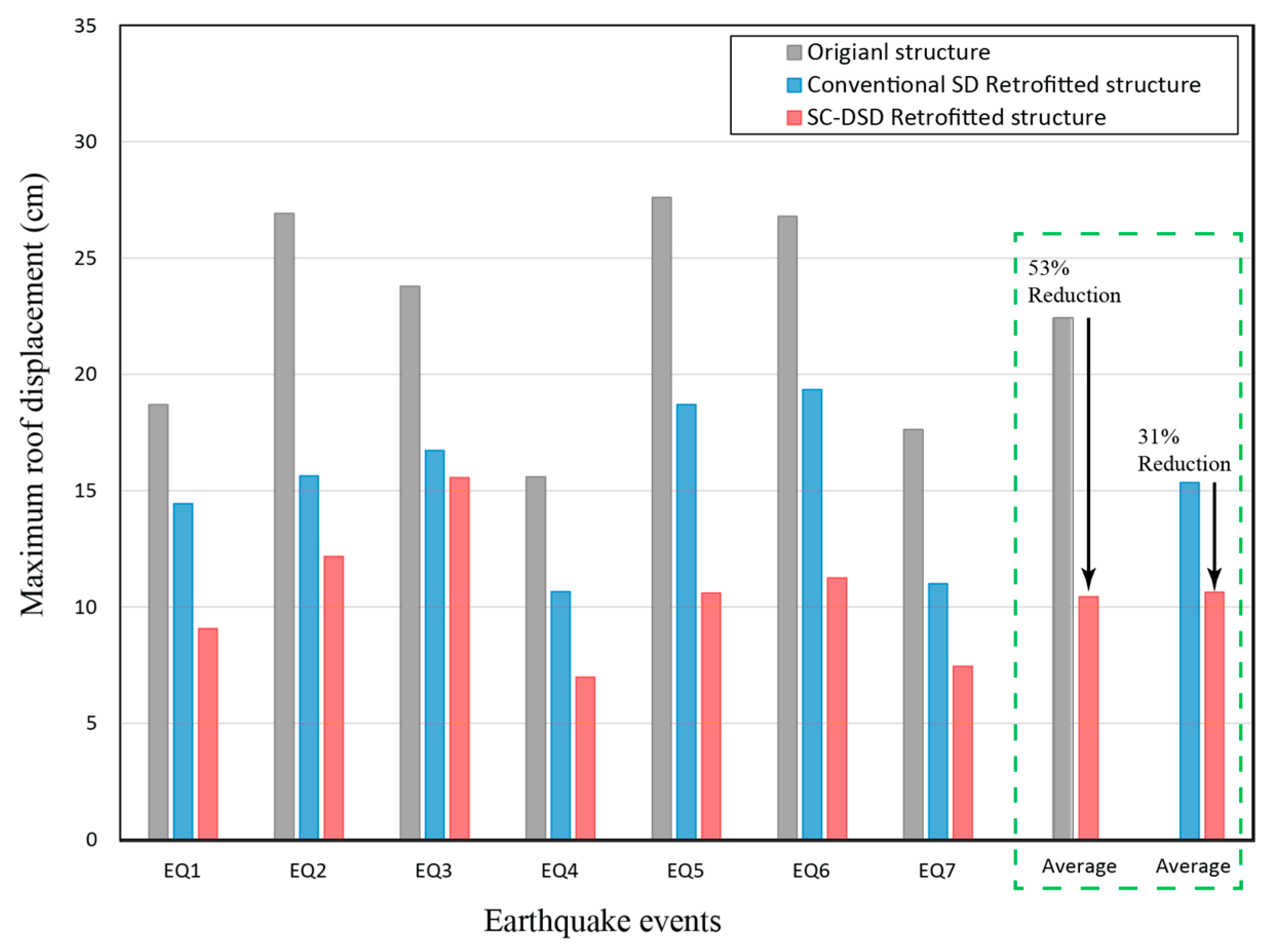
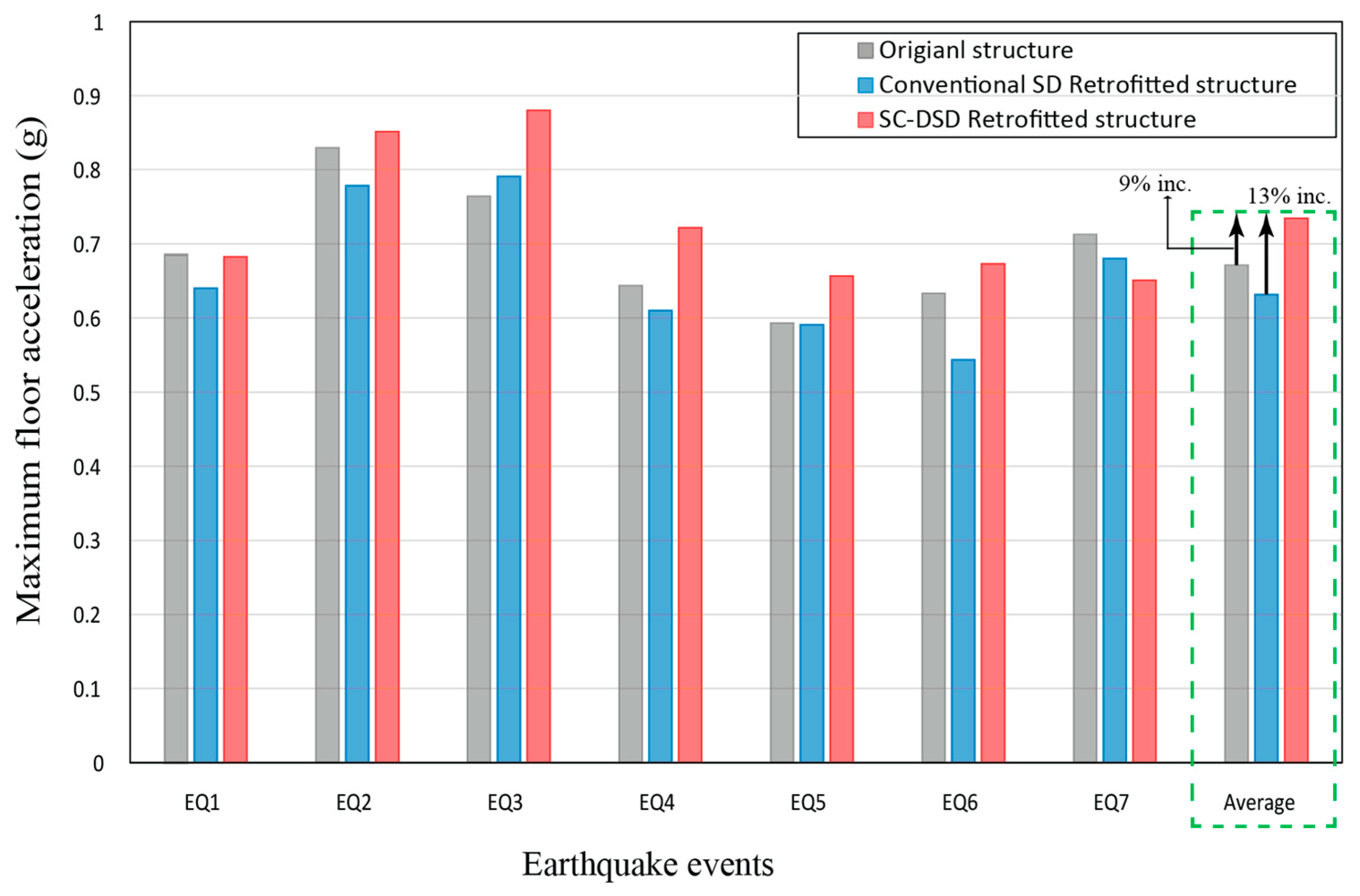
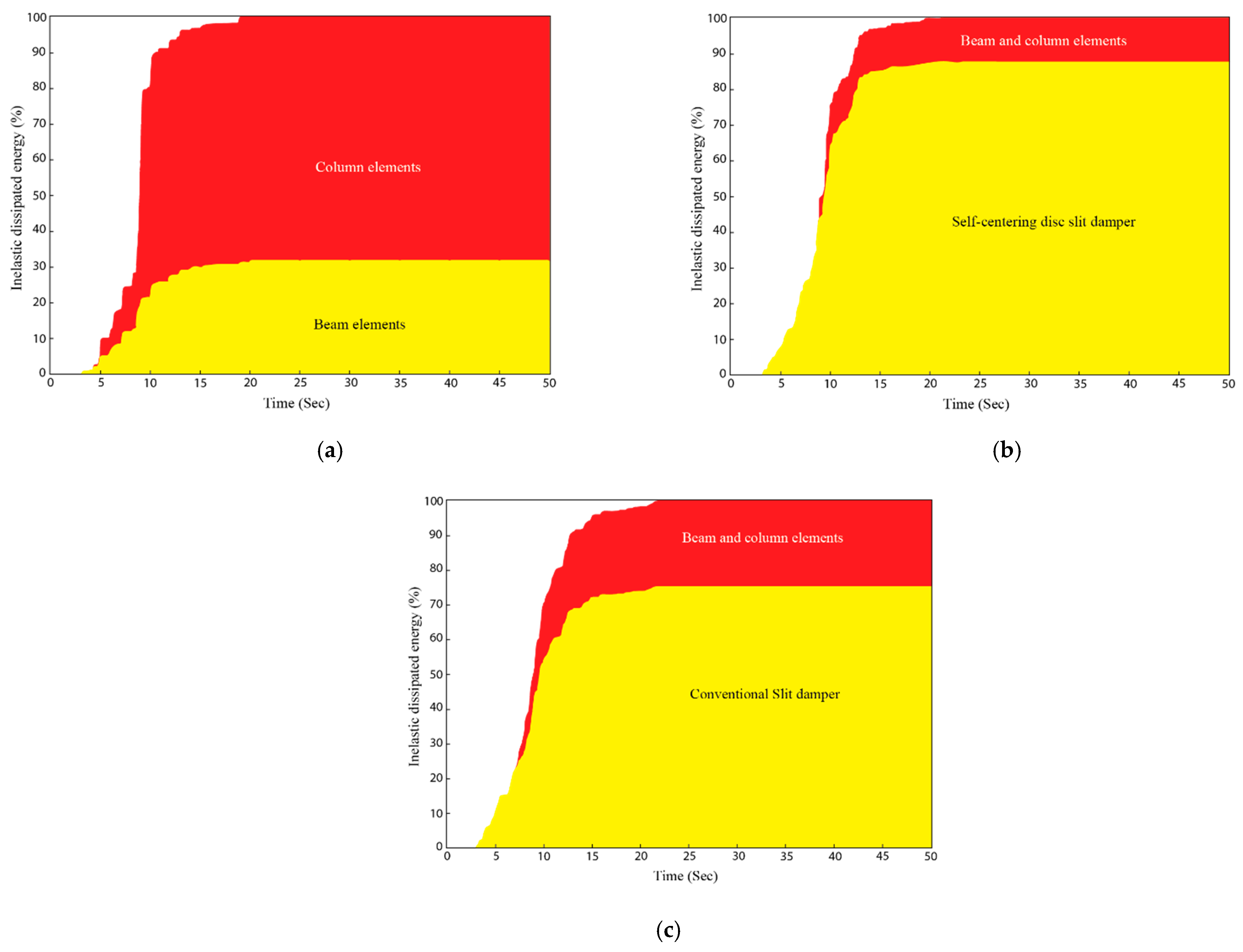
| Properties | Steel Slit Damper | Properties | Disc Springs |
|---|---|---|---|
| Material | JISG-3446 | Material | JIS-SUP-10 |
| Elastic Modulus (GPa) | 220 | Elastic Modulus (GPa) | 200 |
| Yield Strength (MPa) | 400 | Yield Strength (MPa) | 350 |
| Section | HSS 200 × 200 × 12 | Section | 125–64 (125 mm outer dia and 64 mm inner dia) |
| Thickness (t) x width (b) of steel strip (mm) | 10 × 10 | Thickness of disc (mm) | 8 |
| No. of steel strips | 8/side (total 32) | Prestress load (kN) | 64 |
| Length of steel strip (mm) | 100 | Configuration of disc springs | 2 Parallel disc springs combined 8 in series |
| Stoke (mm) | 30 | Flatness load (kN) | 270 |
| Stoke (mm) | 30 |
| Story | Beam | Cross-Section Size (mm) | Rebar Reinforcements | |||
|---|---|---|---|---|---|---|
| Ends (I, J) | Mid Span | |||||
| Bottom | Top | Bottom | Top | |||
| 1-2 | B-1 | 300 × 540 | 2-D19 | 6-#19 | 5-#19 | 2-#19 |
| 1-2 | B-2 | 300 × 560 | 2-D19 | 8-#19 | 6-#19 | 2-#19 |
| 1-2 | B-3 | 300 × 520 | 2-D19 | 7-#19 | 3-#19 | 2-#19 |
| 3-6 | B-1 | 300 × 450 | 2-D19 | 5-#19 | 5-#19 | 2-#19 |
| 3-6 | B-2 | 300 × 450 | 2-D19 | 8-#19 | 7-#19 | 2-#19 |
| 3-6 | B-3 | 300 × 430 | 3-D19 | 8-#19 | 5-#19 | 2-#19 |
| Story and (Column Section) | Cross-Section Size (mm) | Rebar |
|---|---|---|
| 1 (C-1) | 450 × 450 | 8-#19 |
| 2~4 (C-1) | 400 × 400 | 8-#19 |
| 5~6 (C-1) | 350 × 350 | 8-#19 |
| 1 (C-2) | 650 × 650 | 16-#19 |
| 2~4 (C-2) | 600 × 600 | 12-#19 |
| 5~6 (C-2) | 550 × 550 | 16-#19 |
| 1 (C-3) | 500 × 500 | 12-#19 |
| 2~4 (C-3) | 450 × 450 | 8-#19 |
| 5~6 (C-3) | 450 × 450 | 16-#19 |
| EQ Serial No. | Record No. in PEER | Earthquake Name | Station Component | PGA Max. (g) | Magnitude (Mw) | SF | Rrup (km) | Vs30 (m/s) | Lowest Usable Freq. (Hz) |
|---|---|---|---|---|---|---|---|---|---|
| EQ 1 | 68 | San Fernando | SFERN/PEL180 | 0.23 | 6.61 | 2.1 | 22.7 | 316.46 | 0.1 |
| EQ 2 | 174 | Imperial Valley | IMPVALL/H-Ell230 | 0.39 | 6.53 | 1.2 | 12.5 | 196.25 | 0.1 |
| EQ 3 | 721 | El Centro | SUPERST/B-ICC000 | 0.36 | 6.54 | 1.3 | 18.2 | 192.06 | 0.08 |
| EQ 4 | 752 | Loma Prieta | LOMAP/CAP000 | 0.53 | 6.91 | 1.5 | 8.56 | 288.62 | 0.25 |
| EQ 5 | 953 | Northridge | NORTHR/MUL009 | 0.52 | 6.73 | 1.1 | 9.44 | 355.81 | 0.15 |
| EQ 6 | 1111 | Kobe Japan | KOBE/MIS000 | 0.51 | 6.90 | 1.2 | 7.08 | 609.0 | 0.12 |
| EQ 7 | 1485 | Chi-Chi | CHICHI/CHY101-E | 0.44 | 7.62 | 1.3 | 26.0 | 704.64 | 0.05 |
Disclaimer/Publisher’s Note: The statements, opinions and data contained in all publications are solely those of the individual author(s) and contributor(s) and not of MDPI and/or the editor(s). MDPI and/or the editor(s) disclaim responsibility for any injury to people or property resulting from any ideas, methods, instructions or products referred to in the content. |
© 2024 by the authors. Licensee MDPI, Basel, Switzerland. This article is an open access article distributed under the terms and conditions of the Creative Commons Attribution (CC BY) license (https://creativecommons.org/licenses/by/4.0/).
Share and Cite
Naeem, A.; Koichi, K.; Lee, J. Seismic Performance Evaluation of Reinforced Concrete Building Structure Retrofitted with Self-Centering Disc-Slit Damper and Conventional Steel Slit Damper. Buildings 2024, 14, 795. https://doi.org/10.3390/buildings14030795
Naeem A, Koichi K, Lee J. Seismic Performance Evaluation of Reinforced Concrete Building Structure Retrofitted with Self-Centering Disc-Slit Damper and Conventional Steel Slit Damper. Buildings. 2024; 14(3):795. https://doi.org/10.3390/buildings14030795
Chicago/Turabian StyleNaeem, Asad, Kusunoki Koichi, and Joohno Lee. 2024. "Seismic Performance Evaluation of Reinforced Concrete Building Structure Retrofitted with Self-Centering Disc-Slit Damper and Conventional Steel Slit Damper" Buildings 14, no. 3: 795. https://doi.org/10.3390/buildings14030795






